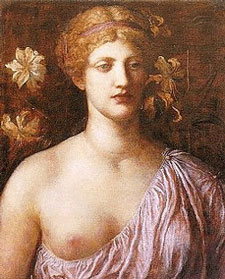Stories
This is a story told by Carlos Parada, Author of Genealogical Guide to Greek Mythology at Brown University.

Pygmalion is the king of Cyprus who fell in love with a statue of his own making, kissed the ivory statue and thought the kisses were returned. He talked to it with words of love and brought to it the kind of gifts that are thought to please girls, such as shells and pebbles, little birds and flowers of all colors. Besides all this he also draped it with robes, put rings upon its fingers and a necklace around her neck. And by night Pygmalion put the statue on a bed, called it the consort of his bed and rested its head upon soft pillows.
So when the time came for the festival of Aphrodite to be celebrated, Pygmalion visited it and prayed to the goddess to have as wife one like his ivory maid. Aphrodite understood he did not mean one like his ivory maid but the ivory maid itself. So when Pygmalion returned home and kissed his ivory statue he discovered it was warm as he was kissing not ivory but flesh.
Pygmalion married she who had been a statue and Aphrodite, who had given life to it, came to the wedding. Pygmalion himself was given a long life.
NAI MANGGALE The folklore of Nai Manggale came from the Tapanuli tribe, which lives in the province of North Sumatra. Generally people in North Sumatra are referred as Batakese. This folklore is not famous, but part of is similar to the Greek myth of Pygmalion and Galatea.Datu Panggana was a famous sculptor. When he got an order, he went to the forest to look for the most suitable wood. One day he got an inspiration to craft a wood he found (not to complete an order, just his own desire), and in his workshop he carved the wood to be the statue of a beautiful woman.Then a merchant named Bao Partigatiga passed by, and he decorated the statue with stunning clothes and jewels. Those items became permanently attached to the statue.Bao Partigatiga, angry that his trading items were stuck to a statue, ordered Datu Panggana to destroy the statue so that he could get his clothes and jewels back. Datu Panggana refused, so Bao Partigatiga left in rage. Datu Panggana, however, was also unable to move the statue from its place. He also left the statue in sadness.Then a druid named Datu Partoar saw the statue, and he prayed to God. Later the statue became alive, and Datu Partoar embraced his newly existed daughter. His wife named their step daughter as Nai Manggale.The news about Nai Manggale’s spread rapidly. She honestly told the villagers that she was a statue who/which became a living woman by the grace of God. Datu Panggana went after Datu Partoar to claim his own creation, Nai Manggale. And Bao Partigatiga also claimed his right for the living statue.A village elder, Aji Bahir, solved the dispute and made an agreement about the relationship of those three men and Nai Manggale: Datu Partoar is the father, Datu Panggana is the uncle, and Bao Partigatiga is the brother.
The folklore of Nai Manggale came from the Tapanuli tribe, which lives in the province of North Sumatra. Generally people in North Sumatra are referred as Batakese. This folklore is not famous, but part of is similar to the Greek myth of Pygmalion and Galatea.Datu Panggana was a famous sculptor. When he got an order, he went to the forest to look for the most suitable wood. One day he got an inspiration to craft a wood he found (not to complete an order, just his own desire), and in his workshop he carved the wood to be the statue of a beautiful woman.Then a merchant named Bao Partigatiga passed by, and he decorated the statue with stunning clothes and jewels. Those items became permanently attached to the statue.Bao Partigatiga, angry that his trading items were stuck to a statue, ordered Datu Panggana to destroy the statue so that he could get his clothes and jewels back. Datu Panggana refused, so Bao Partigatiga left in rage. Datu Panggana, however, was also unable to move the statue from its place. He also left the statue in sadness.Then a druid named Datu Partoar saw the statue, and he prayed to God. Later the statue became alive, and Datu Partoar embraced his newly existed daughter. His wife named their step daughter as Nai Manggale.The news about Nai Manggale’s spread rapidly. She honestly told the villagers that she was a statue who/which became a living woman by the grace of God. Datu Panggana went after Datu Partoar to claim his own creation, Nai Manggale. And Bao Partigatiga also claimed his right for the living statue.A village elder, Aji Bahir, solved the dispute and made an agreement about the relationship of those three men and Nai Manggale: Datu Partoar is the father, Datu Panggana is the uncle, and Bao Partigatiga is the brother.
